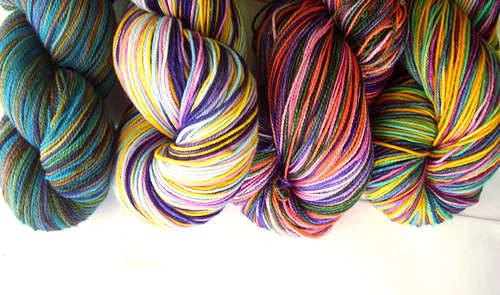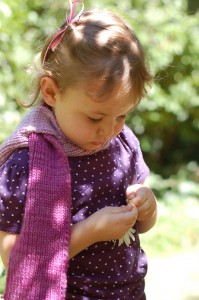 Not so long ago, I had more hobbies than I could keep up with, from SCUBA diving to horseback riding and dancing to snowboarding. Then my son and daughter (now 4 and almost 3) came along, and I found myself struggling to name a single hobby—something, anything, that I can call my own, that I do just because I love to. The combination of parenting and keeping my writing career afloat just didn’t leave space for me. It was time to learn something new.
Not so long ago, I had more hobbies than I could keep up with, from SCUBA diving to horseback riding and dancing to snowboarding. Then my son and daughter (now 4 and almost 3) came along, and I found myself struggling to name a single hobby—something, anything, that I can call my own, that I do just because I love to. The combination of parenting and keeping my writing career afloat just didn’t leave space for me. It was time to learn something new.
So I signed up for a beginner knitting class, certain that—surely—anyone could learn to knit. But as I walked toward the yarn shop, my stomach filled with knots remembering my prior attempts at tasks that required my mind and body to think or move in three dimensions. In my junior high home-economics project, I sewed my sweatpants together in the middle of a leg and mangled the elastic waist band. In my college organic chem lab, I rigged up a contraption of flasks and hoses so poorly that when I turned on the faucet, water shot clear from our lab bench like a firehouse all the way to the blackboard, drenching the instructor’s textbook and notes along the way.
When I got to knitting class and the teacher and the four of us students introduced ourselves, I discovered that I was the sole writer among a group of engineers. The teacher walked us through the basics of how to cast on, knit, and purl. I watched, and observed, and what I observed was that the other three women—the engineers—could watch the teacher and just make their fingers do exactly as hers did. I, however, could not make my fingers stick the needle here or there, under this stitch and behind that one, unless the teacher stopped everything, walked over, and moved my fingers for me, repeatedly.
Little by little, yarn did begin to appear like links of chainmail on my needle, but not without hopeless sighs of consternation and frustration. I couldn’t help but compare myself to the other three students who caught on so effortlessly. The teacher kept trying to make me feel better by making lighthearted comments about how it’s just because I’m a writer, and those engineer types just learn differently—you know, that left brain/right brain phenomenon. I left class feeling downtrodden, insecure, and not at all sure I’d be back the following week. I went home that night and jumped on the website knittinghelp.com, but even trying to follow its beginner videos reduced me to tears.
I returned to class the next week and even received applause from my classmates, who were as surprised as I was that I made it back. I finished my beginner project, a felted tote bag, three months later, after attending multiple help sessions at a local craft shop. The other three students had polished off their projects by the third week of class. (To feel better, I told myself it’s just because they don’t have kids.)
 Yet this experience made me ponder just what it is that makes me, uh, spatially challenged, and what’s the science (if any) behind this left brain/right brain stuff. Although it’s still deeply embedded in our cultural lore, this concept has been pretty thoroughly debunked (see here, here, and here). The idea of a person being either left or right-brain dominant stems from “split-brain research,” which dates back to the 1960s. It revealed that the left and right hemispheres of the brain orchestrate distinct functions: the left side is the center of language and speech, the right the driver of visual, motor, and spatial tasks. This got extrapolated into the idea that some people are more analytical and logical (left brain), while others are artsy, creative types (right brain). It’s been used as a marketing tool to sell Mozart CDs for infants to amp up their spatial cognitive skills and pills to boost creativity. To the chagrin of neuroscientists, the misconception still shapes some teaching curricula and is often tossed around haphazardly by teachers and principals.
Yet this experience made me ponder just what it is that makes me, uh, spatially challenged, and what’s the science (if any) behind this left brain/right brain stuff. Although it’s still deeply embedded in our cultural lore, this concept has been pretty thoroughly debunked (see here, here, and here). The idea of a person being either left or right-brain dominant stems from “split-brain research,” which dates back to the 1960s. It revealed that the left and right hemispheres of the brain orchestrate distinct functions: the left side is the center of language and speech, the right the driver of visual, motor, and spatial tasks. This got extrapolated into the idea that some people are more analytical and logical (left brain), while others are artsy, creative types (right brain). It’s been used as a marketing tool to sell Mozart CDs for infants to amp up their spatial cognitive skills and pills to boost creativity. To the chagrin of neuroscientists, the misconception still shapes some teaching curricula and is often tossed around haphazardly by teachers and principals.
Though it’s a handy paradigm, the brain is far too complex to be broken down into halves. “The brain works by information traveling back and forth, forwards and backwards, left and right, all the time,” says Natasha Kirkham, a development psychologist at the University of London. Both sides of the brain collaborate in a complementary way to perform every single thought and movement we make.
The problem, though, is that neuroscience can’t yet explain the individual differences in why one person learns certain activities better than another, says Charan Ranganath, a cognitive neuroscientist at the University of California, Davis. Science tends to tackle questions at a fine scale, yet drawing it all together to apply it to monumental questions can sometimes lead one to the “land of fiction,” he says. Still, there are intriguing and unanswered questions about how different brain networks are in use when we are applying visual strategies to learn versus language-based strategies. “How those brain networks differ from person to person and how they differ between the two hemispheres is not well understood,” says Ranganath. “But those two factors I’ll bet are related to what make you learn differently from someone else.” And like nature and nurture, shown to be inextricably intertwined, these differences are going to have their roots deep in both genetics and development, he says.
In fact, Kirkham points to research showing that the influence of early exposure plays an important role in the skills and preferences we develop. In the UK, for instance, boys are highly encouraged to play soccer, a skill that requires a lot of spatial coordination. Despite society’s push toward gender neutrality, we still tend to reward boys for high-activity, spirited play such as jumping and climbing trees, and girls toward playing games together and conversing, Kirkham says. “It’s not like we mean to do it, it’s just that’s what happens.” And it’s not mostly via parental influence; research shows that a large fraction of this conditioning happens through differences in educational approaches. Yet this leaves me with even more questions about why my own upbringing, consisting of ranch work such as taking care of horses and pets day in and day out, hoisting water buckets and bales of hay, and riding horses competitively didn’t leave me with more three-dimensional prowess.
Michael Frank, a cognitive neuroscientist at Brown University, studies how we learn to navigate the world through positive outcomes (rewards such as smiles from others) or negative ones (losses, punishments) and how those positive or negative outcomes shape the individual differences in our learning styles. His research shows that the abstract actions that gain us rewards early on in development are the ones we learn to repeat over and over in life, and those patterns help build our preferences and skill sets. This type of learning is directed by specific genes that affect the function of dopamine, a neurotransmitter, in a region in the middle of the brain called the basal ganglia, a massive superhighway of complex circuitry. Dopamine acts as part of the reward system and goes charging along nerve cells to deliver its cues to the basal ganglia: Yes! Good job! Keep it up!, like a pinball game of sorts. “You can think of it as a primitive system that learns to select actions that work for it over the history of its lifetime,” says Frank.

As it turns out, it’s messy. Neuroscience doesn’t yet have an explanation for what makes us the way we are, in all our complexity and with all our glorious strengths and maddening limitations. Perhaps the most heartening aspect I can focus on is that I’m not just one way or the other, analytical OR creative, logical OR artistic.
One thing that I’ve got going for myself is that this ‘learning curve’ that I struggle with pisses me off. And that seems to work to my advantage. The first time I tried snowboarding back in college (a whole different form of three-dimensional thinking and movement from knitting), I smacked my head and wrists against the unforgiving mountain so many times that I was achy and sick for three weeks. And mad. So mad that I was determined to beat it, and to learn how to glide down the mountain in those graceful S curves.
My breakthrough came the next time around, when a mountain guide cruised by and saw the desperation and tear stains on my goggled face: “Pretend you’re on stiletto heels for your toe-side turn,” he said. I’ve not donned many (any?) stiletto heels in my lifetime, but aha! The imagery clicked. Bliss. I rocked back and sank into my heels, and the snowboard obeyed, gliding firmly beneath me.
Same goes for knitting: it has become a divine pleasure, a wonderful procrastination tool, and an outlet for my nervous energy. I’ve just finished up my next project, a scarf, and I’m now a hopeless knitting addict, eager for the day when I’ll be whipping up dreamy lace shawls. I can accept the frustration of learning a new skill when the end result is hours of deep contentment.
***
Amanda Mascarelli is a freelance journalist based in Denver, Colorado. In her ‘spare’ time, she now gets lost gazing at yarn online and in local craft shops.
Images: yarn by madelinetosh, others by Amanda Mascarelli, James Mascarelli
Amanda, I’m your opposite. I don’t much like knitting but when I first learned to do it, somehow my hands already knew how. Or rather, they were awkward at first but picked up the knack quickly. I swear my brain wasn’t involved at all. Now you’ve got me wondering what all this is about but you have to be right: it sure can’t be as simple as left vs. right.
That’s interesting, Ann. I’ve heard something similar from several of the teachers… that your fingers will just take over if you’re not being too mental about it. I did experience that recently – I went to cast on for the first time when I started my second project, and I hadn’t cast on for months, since the beginning of the first class. Suddenly my fingers just flew into action and the yarn magically did exactly what it was supposed to!
That’s a beautiful scarf!
I wonder if muscle memory has anything to do with this? (i.e. theoretically the engineers’ fingers would have been better “trained” at manipulating things?) I remember learning to finger pick my guitar and, for weeks and weeks, well after my brain had grasped what it was I needed to do, my fingers were simply unable to comply. It literally felt like a disconnect between synapse fire and finger tip. Signals were getting lost somewhere on their way down my arm. Then, one magical night, after countless nights of just screwing up over and over, I sat down and played the entire song through without a hitch on the first try.
But, please, don’t entirely debunk right vs. left. It’s how I explain my utter lack of math comprehension…
Thanks, Adam! And yep, you’re absolutely right on the muscle memory. I really wanted to get into that as well but was already pushing the length more than a little. Michael Frank, the Brown U neuroscientist, explains it beautifully and I just didn’t have space to elaborate but I hope to write more on this. Basically, he explains that before skills become natural and automatic (like tying shoelaces, riding a bike, skiing, etc.), they are processed in a more programmed way in the prefrontal cortex, which passes the info off to the basal ganglia where they become more ingrained/instinctual. He thinks that some of the individual differences in the way people learn new skills has to do with how easily they can represent these rules in the prefrontal cortex — in other words, I have a traffic jam in my prefrontal cortex!
I think you nailed it in the middle of the article – it’s not left-brain/right-brain, it’s a spatial deficit. I like to refer to myself as spatially disabled, and yet have picked the arena of improving spatial skills for my research.
Boys do tend to be better at spatial skills because the activities that build spatial skills tend to be boy-designated. Not just sports, but also block building, playing with trains, and video games. I make sure to engage my girls in these activities (well, not video games yet) to build spatial skills. (Spatial skills are correlated with math achievement as well. This tends to be where the ‘boys are better at math’ thing comes from. However, girls tend to outscore boys in computation, so it balances out for overall math achievement, despite the gender gap for spatial skills.)
The good news is spatial skills can be improved. I’ve been working on this for two years now. I figure if I’m going to write about it I should probably try to get good at it, yes? It’s pretty funny how much pride I take in my Thomas the Train train track layouts now. It’s something I could not have done two years ago, though.
And good for you for finding something for yourself. I also think your first argument (you had kids, they didn’t) carries a lot of weight. 🙂